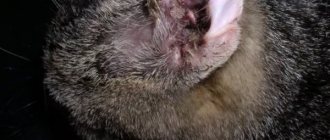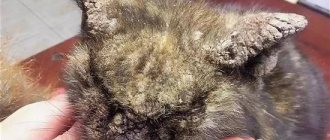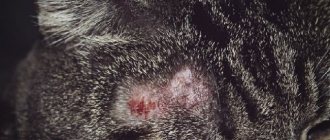Ear mites or otodectosis are a fairly common disease not only among stray cats, but also widespread among pets. And the manifestation of this disease should not be taken lightly. The consequences of neglected painful damage to the cat's body by ticks can be very serious.
Every cat owner should have a clear understanding of the disease picture and know what to do if a tick is detected on their pet. You should also know what an ear mite looks like.
Getting rid of ear parasites can sometimes be quite difficult, so timely treatment and preventive measures are the key to the health of your beloved cat.
Where does it come from - the causes of occurrence
The question “where do ear mites come from in cats” most often worries pet owners, who sometimes never even go outside. The causes of otodectosis can be not only direct contact with stray animals, but also indirect routes of transmission of the disease.
It is known that a cat can acquire this parasite by sharing care items with an infected animal. Ticks are transmitted through a towel or comb.
The leading position as a source of infection is still occupied by homeless animals. They account for about 80 percent of the total number of cases of infection. The anatomical structure of the cat's auricle serves as an additional risk factor for the occurrence of this disease. The cat's owner can also become a carrier of ear mites on clothes, shoes, and even hands. In a kitten, ear mites can occur as a result of infection from the mother.
Prevention of infection
It is no secret that preventing any disease, including otodectosis, is easier than treating it. For prevention purposes, the following rules should be observed:
- Carry out regular inspection and cleaning of your pet’s ears;
- avoid contact with suspicious animals;
- strengthen the cat’s immunity by adhering to the principles of proper nutrition, as well as ensuring that the pet takes the necessary vitamins;
- maintain pet hygiene;
- If you suspect the presence of a tick, you should immediately visit a specialist.
Ear mites in cats: signs and symptoms
You can see what the picture of ear mite disease looks like in the photo. Click to enlarge.
The highest percentage of mite infestation occurs in kittens aged 1 to 6 months and in older or weakened cats.
How can you tell if your pet is suffering from ear mites? There are a number of signs indicating the presence of this arthropod parasite.
The main symptoms of the disease are as follows:
- The animal shakes its head frequently, and a rattling sound may be heard.
- Black wax builds up in the ears, which can lead to stone-like plugs.
- When a cat shakes its head, liquid droplets may spray from the ears.
- Bleeding scratches form in and around the auricle.
- As a result of pus draining from the ears, the hair around the ear may become sticky.
- High body temperature.
- Nervous attacks.
- The cat's constant desire to scratch the affected ear.
- Nervous, restless behavior, sometimes even aggression on the part of the cat.
- Unpleasant odor from the ears.
The listed signs may be complemented by an atypical tilt of the head with the affected ear drooping down. If you have such symptoms, you should consult a doctor to decide how to treat your pet.
Diagnosis of otodectosis
In a veterinary clinic, the diagnosis is made based on examination and examination of the contents of the ear under a microscope.
Basic methods:
- Using a special instrument, the doctor sees moving white dots.
- Studying sulfur under a microscope allows you to examine adults, larvae and eggs.
- The "positive ear" method. The doctor wipes the ear canal, and the cat reacts by trying to scratch with its hind paw.
If inflammation (otitis media) has developed, diagnosis becomes difficult. The fact is that with otitis media, an acidic environment is created in the ear, in which parasites die. Therefore, microscopy may not show results.
Also, before treating for otodectosis, the doctor must exclude other diseases that lead to inflammation of the outer ear: allergies, flea dermatitis and other types of parasites.
Why are ear mites dangerous in cats?
The consequence of advanced ear mite infection in cats can be the development of a serious inflammatory process, which subsequently leads to rupture of the eardrum and hearing loss.
In severe cases, the tick may penetrate the inner ear and damage the lining of the brain. Evidence of an advanced process is systematic seizures that are similar to epileptic ones. This symptomatology can lead to death and the inevitable death of the pet.
Are ear mites dangerous for humans?
The question of whether ear mites can be transmitted to humans and whether they can be contracted from pets has an ambiguous answer. The risk of otodectosis for humans is a small percentage.
It has been scientifically proven that the dangerous disease is not transmitted to humans. Still, some experts recommend caution when interacting with a sick pet. It is possible that otitis may develop in people with weakened immune systems when caring for an infected animal without following safety precautions.
Treatment of ear mites in cats
Ridding your pet of ear mites at the onset of the disease will not be difficult. If you notice symptoms indicating a possible infection in your pet, you should immediately consult a doctor. You cannot diagnose or treat your pet on your own! Why?! Because this can aggravate the situation and waste time, and in the meantime the disease can move to the next stage.
Only a doctor determines how to treat otodectosis, taking into account the stage of the disease, the age of the animal, its state of health, and the presence of pregnancy in cats.
With the help of special medications, ear diseases are treated with great success. A prerequisite before treating the ears is to clean them.
This should be done as follows:
- A cotton pad or cotton swab is moistened in one of the products - chlorhexidine or 2% hydrogen peroxide solution, or camphor alcohol
- Cleaning the ears
- Then apply the amount of ointment specified by the doctor or instill the required number of drops.
- The auricle is gently massaged at the base to distribute the product evenly.
It is worth remembering that parasites can live on a cat's body, so antiparasitic drugs should be used on the entire surface of the body. During the treatment period, it is necessary to provide the cat with a varied fortified diet and access to fresh air. To kill ticks indoors, you should clean with acaricidal agents.
Rules for cleaning ears at home
Before carrying out the procedure, be sure to clean your cat's ears. This must be done regardless of the drug used, even if there is no such indication in the instructions for it.
As tools you will need:
- cotton pads to remove plaque;
- cotton swabs (it is not recommended to use homemade devices in the form of cotton wool wound around a match, this can cause damage if you are careless);
- cleaning agents (chlorhexidine, hydrogen peroxide, boric acid solution at a concentration of 3%).
Advice: if your pet is not accustomed to this kind of event or has an intractable character, arm yourself with a towel or sheet in which to swaddle the animal.
The sequence of the procedure for cleaning a pet's ears:
- Place the cat on your lap after covering it with a blanket. Calm down. Remember that for the animal, your desire to cure it is still perceived as a stressful situation.
- Gently bend the auricle and wipe the surface from dirt.
- Gently clean the affected area with a cotton swab soaked in a disinfectant solution. Never pick an animal's ear with pressure.
- Apply the drug. Massage lightly.
- Give the cat a chance to shake its head. Afterwards, wipe the inside of the ear and the hair around it with the same composition.
Medicines
To treat ear mites, medications are used in the form of sprays, powders, ointments, solutions, as well as injections.
At the initial stage, the following is prescribed:
- "Amit"
- "Acromectin"
- "Amitrazine"
- "Tactician"
Special preparations in the form of sprays, such as Tsiodrin, Acrodex, Dermatosol, can simply be sprayed on the area of the affected ear, approximately at a distance of 5 -5.5 cm from it.
To reduce the appearance of itching and relieve inflammation, Otonazole drops are prescribed. Ointments with sulfur compounds can be called effective - Sulfur ointment, Vishnevsky ointment.”
In advanced stages of the disease, Otodectin is used.
Symptoms of demodicosis
Mites destroy the cells of the follicle walls and sebaceous glands. This leads to the appearance of keratinization, foci of inflammation, and pigmentation. Demodex migrates across the skin, exploring new areas; Thus, with increasing demodicosis, the signs of damage spread over an increasingly larger area. It is also assumed that mites cause sensitization of the body, that is, an allergic reaction is added to mechanical damage.
The main symptoms of demodicosis are:
Acne (acne)
Juvenile acne in most cases is a manifestation of demodicosis.
Skin redness
Redness may be accompanied by swelling of the skin.
Itching
Itching with demodicosis usually intensifies at night, when mite activity increases.
More about the symptom
Skin changes
Progressive demodicosis leads to changes in the skin: roughening, peeling, and the appearance of thickenings similar to scars. In the advanced stage, the skin takes on an earthy color.
Blepharitis
When Demodex affects the eyelashes, signs of blepharitis (inflammation of the ciliary edge of the eyelids) develop: the eyelids begin to itch, turn red, swell, and may stick together. The eyes water, inflammation spreads to the conjunctiva - conjunctivitis develops. Loss of eyelashes is observed.
Folk remedies for ear mites in cats
Folk remedies are used purely at the initial stage.
The following folk remedies for ear mites in cats are successfully used at home
- Brewing green tea. Place in ears several times a day.
- Infuse a mixture of ½ clove of garlic and 2 tablespoons of almond oil for 24 hours, and after straining through gauze, lubricate the ears with it once a day. Reviews from owners indicate the effectiveness of using pure almond oil, without adding garlic.
Briefly about the pathogen
Otodectes cynotis, the causative agent of the disease, is so small that it is difficult to see with the naked eye. Its body dimensions are approximately 0.2-0.5 mm. However, if you examine with a magnifying glass what an ear mite looks like, you can see slowly moving pale yellow, white dots. The parasite feeds on skin scales from the ear canal of animals. Lives on the surface and does not dig.
The life of a tick lasts 3 weeks:
- Females lay eggs and attach them to the skin with a viscous substance and cement them. Each female lays 5 eggs per day.
- After 4 days the larvae appear. Within 3-10 days they begin to actively feed. Then comes the rest phase (from 10 to 30 hours).
- The cycle changes and the larvae move into different stages of development (protonymph and deutonymph).
- While in the deutonymph stage, the larvae attach themselves to the males. And if the deutonymph is a future female, then when she becomes an adult, she already turns out to be a carrier of eggs.
An adult lives on average 2 months. Life outside the animal lasts approximately 12 days.
How long does it take to treat ear mites in cats?
A cat affected by ear mites can be quickly cured only if the disease is detected in the early stages. If the process is neglected, you will have to fight for a long time. It will be necessary to carry out a full course of treatment, which can last from 7 to 10 days. The treatment process, in order to completely remove ticks, cannot be stopped before the specified period.
After a successful course of treatment, the black contents in the ears disappear. In this case, the black plaque changes its color to brown.
Preventing ear mites in cats
Prevention of ear mite infection involves eliminating contact between your pet and street animals. Ear mites in a cat can result from other factors. It is necessary to examine the cat every time after a visit to the clinic, mating in someone else's house, or a walk on the street. You should avoid using items from other animals and carefully monitor your pet’s hygiene and health. The cat should not be allowed to rub against outdoor shoes or clothing. It is necessary to carry out mandatory wet cleaning in the house with special anti-tick products.
Otodectosis is a common disease in cats that is caused by the Otodektos cynotis mite. These mites parasitize on the surface of the skin, most often in the ear area; they feed on skin cells, lay eggs there and reproduce. The activity of this mite causes excessive discomfort to cats and damages the ear canal. If treatment for otodectosis is not started in time, mites can cause complications of the disease. The main danger of ear scabies is putrefactive deposits secreted by mites, which can cause putrefactive otitis media.
Many animals are susceptible to otodectosis, including cats. Otodectosis is transmitted from cat to offspring. Interspecies transmission is also possible, for example from cat to dog. This disease is not dangerous for people, since they do not get it from animals.
Pathogen
The scabies mite is a tiny parasite measuring 0.45 mm. Accordingly, it is almost impossible to identify it with the naked eye. The tick has a tortoiseshell-shaped oval body, and instead of forelimbs it has claws. The structure of its mouthparts allows it to tear off pieces of the victim's skin. An ear mite can only move in one direction because its back is covered with scales that point in one direction. The parasite makes passages inside the skin, along which it moves and lays eggs in them. The life cycle of the scabies mite is about 30 days. During this time, the males fertilize the females; they, in turn, manage to lay several eggs in the tunnels. Ear mites are always actively moving, especially at night, this causes a lot of trouble for the animal. The tick feels most comfortable in conditions of high temperature and humidity; at temperatures below zero, it dies in just a couple of days.
Sources of infection and pathogenesis
A cat can bring a tick and, as a result, get sick with otodectosis in the following cases:
- Infected by another, sick animal. Moreover, it does not have to be a cat, since scabies mites can also be found on other animals. This is the most common cause of otodectosis. Of course, letting animals go for a walk is not recommended for many reasons, but if you do this, then carefully examine the cat after each outing.
- Tick eggs may end up on the pet owner's clothing. For example, if a person walked on the ground, and a sick dog or cat was scratching on it, eggs can get on shoes or pants. Or if the owner of the animal was visiting, and a sick cat rubbed against his clothes.
Once a cat is infected with otodectosis, mite waste will appear in its ear canal. When this waste ends up in wounds from parasite bites, very severe itching appears, and the animal begins to scratch itself, often until it bleeds. If treatment is not started in a timely manner, there is a risk of developing otitis media in the inner area of the ear. And in the most advanced cases, parasites can enter the brain, which can lead to the appearance of purulent meningitis. Its treatment is much more complex. Therefore, we advise you not to delay treatment of otodectosis. Ticks are the most dangerous for a kitten. Their immune system is still very weak, so they suffer great harm, which means the threat of otodectosis and, in the worst case, death increases significantly.
For humans, these parasites are not a strong threat, since ear mites cannot live on the human body. But they can provoke the appearance of pseudo-scabies - manifestations of an allergy to bites. The person does not need treatment, since the problem will disappear on its own when the cat is cured.
Symptoms of otodectosis
Otodectosis most often occurs in young cats. The main symptom of the disease is excessive secretion of wax from the external ear canal. It has a dry or wet crust that looks like ground coffee in color and consistency. If there is too much of it, sulfur can even completely block the ear canal. Inflammation of the outer ear canal can be difficult to diagnose because it can occur with few visible symptoms. But more often, large discharge appears with no or very minimal itching, or the discharge is insignificant, but the itching is severe.
Ear mites most often come out when the cat is lying in a ball shape. They can spread over the neck, body, and tail. In the place where parasites accumulate, the code is damaged due to the fact that the cat actively scratches it. Also common symptoms of otodectosis include receding hairline (alopecia) and dermatitis. If the disease is as advanced as possible, then the inflammation goes deeper and deeper. When the eardrum ruptures, inflammation spreads to the inner ear and then to the lining of the brain. In this case, more noticeable and serious symptoms are observed: lethargy, increased temperature (first local, and then body), the animal’s head is tilted towards the injured side, neurological symptoms are evident: convulsions and seizures.
Treatment of otodectosis
If you find ear mites in a cat, treatment should be timely and comprehensive. Most often, it is not necessary to impose any activity or diet restrictions on the animal, with the exception of damage to the vestibular apparatus. In this case, the cat needs surgery.
Treatment of otodectosis is carried out according to the following algorithm:
- Elimination of inflammation (if the cat has become infected with secondary flora in a complicated form of otodectosis), relieving pain and itching.
- Cleansing, prescribing acaricidal drugs, preventing re-infection and spread of the pathogen.
The disease is very contagious for animals, so those animals that have been in contact with the infected need to be treated with anti-parasite agents and their bedding treated, since they can also be a source of re-infection.
For any form of the disease, anti-tick treatment must be carried out. Treatment should be carried out very carefully, since even a small amount of some products can cause poisoning to the pet.
The most effective ear drops against ticks include Aurican. This is a complex remedy that has antiseptic, anti-inflammatory, bacteriostatic, bactericidal, insecticidal and local anesthetic effects. Place 5-20 drops into each ear of a sick animal (the amount depends on the size of the cat). You need to drip once a day for 7 days, then once a day 2 times a week for a month. The drug should not be used if the animal has a perforated eardrum and is hypersensitive to the components of the drops.
Ordermil ointment helps well in the treatment of otodectosis. It will help the animal maintain its hearing and neutralize ear infections. Before applying the ointment, it is necessary to clean the ear canal and sink with cotton wool and Vaseline oil, this will enhance the effect of the treatment. Next, apply a drop of ointment into the ear canal and distribute it in the ear, massaging it and thereby warming it up. If your pet has one ear affected, the ointment still needs to be applied to both. Repeat the procedure 2 times a day for 7-12 days.
If otodectosis has caused severe itching in your cat and it damages its ears while scratching, you need to put a protective collar on the cat. In most cases, such an advanced form of otodectosis requires the use of anti-inflammatory and painkillers.
To speed up recovery, we recommend cleaning your animal’s ears with lotions. Please note that lotions can only be used if the integrity of the eardrum is not damaged. You need to clean your cat's ears as carefully as possible so that it doesn't hurt it. Tools for cleaning ears (cotton wool, cotton swabs) should be placed in a sealed bag and disposed of immediately after the procedure is completed in order to prevent re-infection.
Epi-otik, Otifri, and Global vet lotions have proven themselves well. They maintain the health of the animal’s ears, successfully help get rid of unpleasant odor from the ears and old ear crusts, and have a beneficial effect on the microflora of the ear. Lotions soothe the skin and relieve itching. They can be applied before using medications. These lotions can be used 2-3 times a day until the symptoms disappear completely. You can then use it up to 2 times a week to maintain ear hygiene.
Effective means in the fight against otodectosis are drops on the withers. Stronghold antiparasitic drops actively fight ticks that parasitize cats and dogs. The drug has ovicidal and larvicidal properties, and has acaricidal and nematicidal effects. The great advantage of Stronghold is that it remains in the tissues and organs of the animal for a long time, thereby destroying parasites and providing protection against reinfestation for a month. The drug component selamectin interacts with the receptors of parasite cells, increasing the sensitivity of membranes to chlorine ions, thereby blocking the muscle and nerve cells of the parasites, which leads to paralysis and subsequent death. Stronghold is well tolerated by animals of different breeds.
Solution Advocate has a wide range of actions to combat parasites in animals. The solution is applied once to the intact dry skin of the animal, the volume is calculated based on the weight of the cat. If necessary, the course of treatment should be repeated after a month. Advocate should not be applied to damaged or damp skin. It is prohibited to wash the animal for 4 days after application, and it should not be used simultaneously with medications that contain macrocyclic lactones. After using Advocate, you do not need to pet the animal in the application areas and do not allow it near children for 24 hours.
Prevention of otodectosis
Without proper treatment, serious complications of otodectosis can develop, such as hearing loss (partial or complete) and even death if the brain is affected. Such complications, fortunately, are quite rare, but nevertheless it is necessary to take proper preventive measures to the maximum.
The most reliable preventive measure is treating the animal with anti-tick products, constantly examining the cat's ears, and in case of the slightest suspicion, immediately contacting a veterinarian. Regular cleaning of the cat's premises and bedding will help reduce the risk of infection. If the cat walks freely on the street, then treatments with sprays or drops on the withers should be carried out at least once a month. Remember that the attentive and responsible attitude of the owner is the key to the health of the pet!
Veterinarian advice
Veterinarians specializing in the treatment and prevention of feline ear diseases recommend that cat owners use special flea and tick collars to protect their pets. After an illness, re-infection may occur, since immunity to this parasite is not developed.
Video with veterinarian advice:
By paying close attention to the problem of ear mite infestation, you can achieve a positive result and save your animal from a serious illness. Timely and high-quality treatment will return your pet to health and leave no chance for ticks.










